Nearly every big change in how we eat starts as a fad,
which is really just a shared moment among a subset of diners or cooks that
gains traction. Some fads fade away slowly, like wine coolers or molecular
gastronomy. Others implode suddenly, like turmeric lattes or the pink sauce
that shot up like a rocket on TikTok this year and then exploded.
اضافة اعلان
There are fads that build into trends and then become woven into
the fabric of our day. Who knew that a fringe interest in custom-roasted coffee
beans in 1960s Berkeley, California, would lead to Starbucks?
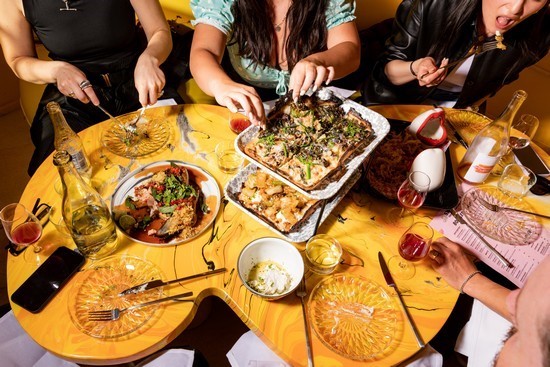 Patrons dine at
Shuggie’s in San Francisco on July 7, 2022.
Patrons dine at
Shuggie’s in San Francisco on July 7, 2022.
It is hard to tell the fleeting from the lasting, but that does
not keep a lot of people from trying. We waded through dozens of reports and
news releases, and interviewed the best food forecasters in the game to peer
into the 2023 food crystal ball.
In a time of inflation, climate change, and global tensions,
some predictions seem grim. “We’re fatigued,” said Jennifer Zegler, a director
of food and drink for the global market research group Mintel. “Simplicity,
versatility, escapism, and resourcefulness are what our trends boil down to
this year.”
All is not bleakness. High-end Jell-O shots, bright naturally
colored fare, and packaging that evokes the ’70s are in. Food and drinks that
make you feel healthier will continue to proliferate, too. “People want
something fun, and they want newness and they want natural,” said Claire
Lancaster, who forecasts food and drink trends for WGSN.
Here are 10 interpretations of the tea leaves.
Flavor of the yearEmbrace the brine. Fresh, bracing marine flavors have spawned a
craze for coastal cocktails garnished with crab claws and oysters. Dan Levy,
the actor, and host of “The Big Brunch,” is making Clamato cool. Sea vegetables
like kelp and sea creatures like uni have secured spots on several trend lists.
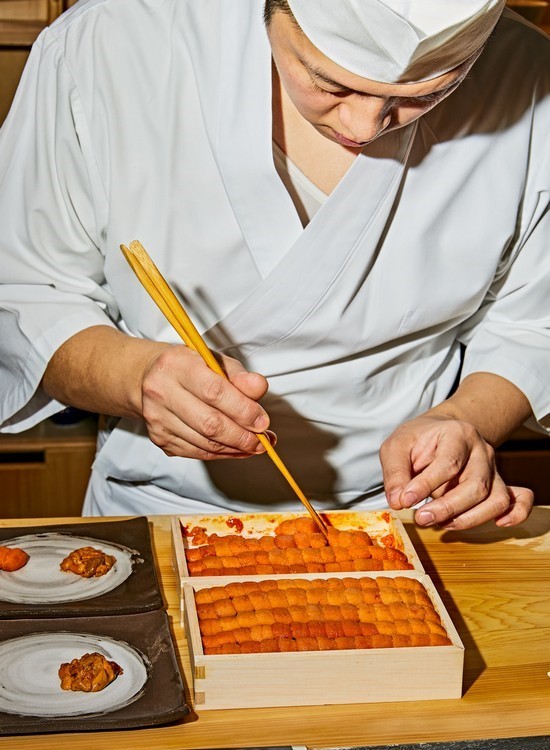 The chef Shion Uino prepares a dish at Shion 69 Leonard
Street in New York, on November 17, 2021.
Word of the year
The chef Shion Uino prepares a dish at Shion 69 Leonard
Street in New York, on November 17, 2021.
Word of the yearCalling yourself a climatarian is so 2022. The new term is
regenivore. It is no longer about eating sustainably, which implies a state of
preserving what is. A new generation wants food from companies that are
actively healing the planet through carbon-reducing agriculture, more rigorous
animal welfare policies, and equitable treatment of the people who grow and
process food.
Look for big changes to reduce waste in packaging. More chefs
will use what Mintel calls “climate hero ingredients” like teff, fava, and
lupin beans, and more diners will choose food and drink that improve their
health and the planet’s. Even the alcohol industry has started throwing around
words like eco-alignment. “These companies don’t want to just be seen as doing
the right thing daily,” said Joan Driggs, who studies retail trends and
consumer packaged goods for IRI, a data analysis company. “They want to be
really seen as making a positive difference.”
 Cattle on Lindsay Klaunig’s farm outside Athens, Ohio, on
September 20, 2022.
Snack of the year
Cattle on Lindsay Klaunig’s farm outside Athens, Ohio, on
September 20, 2022.
Snack of the yearChicken skins have been trying to elbow out chicharrones for
some time, but this may be their year. Riding the wave of an obsessive interest
in all forms of fried chicken, crispy chicken skins are the base for nachos at
pop-ups, and sauced and spiced as appetizers in restaurants. Rising chicken
prices have chefs looking for ways to get more from the bird. Asian cuisines
that regularly use chicken skins are providing culinary inspiration.
 Baked chicken skin.
Baked chicken skin.
Chris Moyer, the executive chef for Perdue, placed the skins
high on his list of most promising chicken products and likes them in place of
croutons in salads or as toupées for roasts. And then there is the crunch
factor, which more than 70 percent of consumers say they look for in a snack,
said Denise Lefebvre, senior vice president of R & D for PepsiCo Foods.
“People love the crunch,” she said. “Anything that amplifies the senses is big
now.”
Japan-adjacencyJapanese food is the cuisine all the other cuisines most want to
hang out with. “Chefs throughout the world, many of Japanese descent, are
fusing Japanese ingredients or culinary techniques with foods they love from
their surroundings,” according to AF&Co and Carbonate, two San Francisco
firms that collaborate on an annual hospitality trend report.
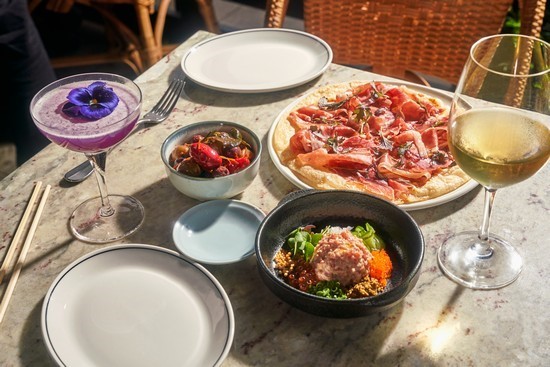 Dishes from Kimika,
which serves Japanese-Italian food, in New York on April 10, 2021.
Dishes from Kimika,
which serves Japanese-Italian food, in New York on April 10, 2021.
In New York, the restaurant Kimika is a popular practitioner of
itameshi, the combining of Italian and Japanese cooking. Nikkei, the mashup of
Peruvian and Japanese cuisines, is on display at places like Causita in Los
Angeles, where Peruvian potatoes stand in for sushi rice. At Ethel’s Fancy in
Palo Alto, California, a fourth-generation Japanese American chef is defining
California-Japanese cooking. Even Nordic chef René Redzepi is getting in on it:
His next big-ticket Noma pop-up will be in Kyoto.
The thrill of thriftInflation, fears about climate change and growing concern about
waste and conspicuous consumption are driving a new interest in frugality.
“People are no longer embarrassed and hiding their coupons,” Lancaster said.
Social media is filled with money-saving tips for the kitchen, and menu hacks
to get cheaper items at Starbucks and other restaurants. Energy costs, both
monetary and environmental, are expected to persuade home cooks to increase the
use of small appliances like microwaves, air fryers, and electric kettles
rather than turn on the oven. Private-label supermarket brands and restaurants
that offer shorter menus and more value are gaining speed. “Expect a stronger
focus on durability, flexibility, and timelessness as consumers seek to buy
less and own products that last longer and serve multiple purposes,” Simon
Moriarty, director of Mintel Trends, writes in his report on the coming year.
 Shoppers at a grocery store in Manhattan on August 28, 2022.
Tuber of the year
Shoppers at a grocery store in Manhattan on August 28, 2022.
Tuber of the yearUbe, a slightly nutty-tasting, vanilla-scented purple yam from
the Philippines, is showing up on lots of trend lists and in all kinds of foods
and drinks, from pies and waffles to lattes and ube coladas. It easily made the
list of colors and flavors that capture the mood of 2023 compiled by
food-processing giant ADM. The yam’s popularity is riding on an interest in
food with bright, natural colors like dragon fruit, lychee, and purple Peruvian
corn. Also rising: floral flavors like vetiver and ylang-ylang.
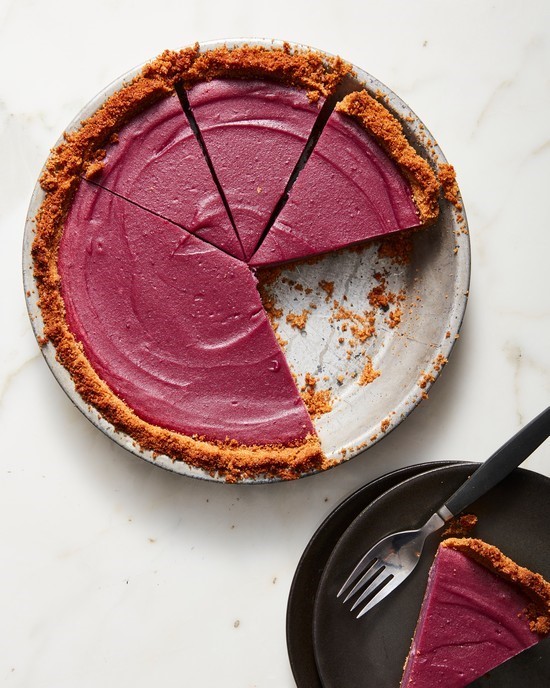 Ube pie.
One giant step for brand kind
Ube pie.
One giant step for brand kindIn the same way that the Apollo era popularized Tang and
freeze-dried ice cream, a renewed interest in space travel will influence how
we eat and drink in 2023. Anything having to do with space will be big as
people look for the optimism and inspiration that seem in limited supply on
Earth. Already, there are climate-friendly Moonshot crackers (the wheat was
farmed using regenerative methods) and Starlight, a limited-release Coca-Cola
drink that calls itself “space flavored.” (What exactly space tastes like has
spawned deep debate online.) “Top Chef” contestants cooked for astronauts this
year. Experiments in growing food in space will fuel interest in vertical
gardening and vegetables that can grow in stressed environments on Earth.
 Briny flavors, high-end Jell-O shots, a fascination with
outer space, and a concern for Earth will guide our choices. At least that’s what
the food forecasters say.
Briny flavors, high-end Jell-O shots, a fascination with
outer space, and a concern for Earth will guide our choices. At least that’s what
the food forecasters say.
“The undiscovered novelty of outer space will have a
particularly unsullied charm for Gen Z, who are disillusioned with the world as
it is,” said Zegler of Mintel. “But brands should also consider the
inspirational role space will have in Gen Alpha’s lives.”
Experiential eatingAfter nearly three years of restricted social interaction and
ordering in, people will seek out restaurants that offer interaction,
excitement, and a bit of a show. Look for more dining-room trolleys, elaborate
ice sculptures, flaming desserts like baked Alaska, and cocktails finished
tableside with a puff of smoke or a change of color. Food and music will mix in
new ways, like updated versions of the old-school piano bar. “There’s a quest
for interaction,” said Andrew Freeman, a hospitality public-relations veteran
in San Francisco. “People are willing to spend, but they are going to be
looking for the value proposition of the experience. Engagement is the
catchword.”
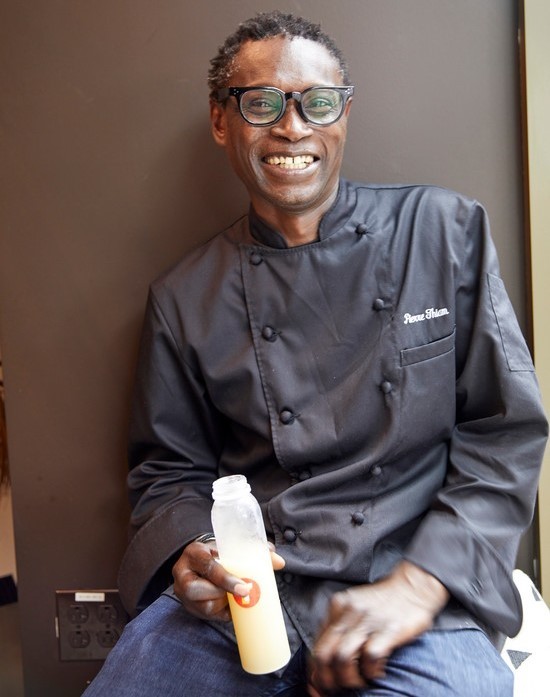 Chef Pierre Thiam of Teranga, in New York, on June 18, 2019.
Deeper into West African cuisine
Chef Pierre Thiam of Teranga, in New York, on June 18, 2019.
Deeper into West African cuisineNigerian food, with its rich and varied layers, will be a
breakout star in US as chefs and diners who are unfamiliar with West African
cooking start to understand it from a regional perspective, in the way a
general interest in Italian cooking eventually led to an appreciation for the
cuisine of Tuscany or Sicily.
In Brooklyn, Nigerian chef Ayo Balogun’s Dept of Culture offers
an experience that is as much a dinner party as a restaurant. Kwame Onwuachi is
playing around with a version of egusi stew at Tatiana, which just opened at
Lincoln Center. Fonio, a drought-resistant African grain that suggests a
marriage between couscous and quinoa, is being championed by chefs like Pierre
Thiam and Alon Shaya. Even Mexican food is getting a Nigerian twist. At Naija Boy
Tacos in Sacramento, California, Nigerian American chef Rasheed Amedu is
serving curry goat on plantain cassava tortillas and seasoning chicken with the
street-kebab spice called suya.
Vibe of the yearCommunal eating understandably fell out of favor during the
pandemic, and many people are not ready to return to buffets or reach into the
same chip bag. But forecasters see a change coming. “If you look at what our
lives were like for a couple of years, we did not share because sharing was
considered dangerous,” said. Lefebvre of PepsiCo Foods. “Now the sense of
community has never been stronger.”
That is in part why her company in November introduced Minis,
tiny versions of snacks like Cheetos and Sun Chips in canisters that make it
easier to pour some into a friend’s hand. It is also behind the growing
popularity of appetizer and dessert towers, and large-format cocktails like the
$100 Disco Mule served in a big disco ball at the Tipsy Alchemist in Austin,
Texas. And there might be no better indication than the rising popularity of
food for a crowd than the continued growth of food served on a communal board
that started with the charcuterie craze.
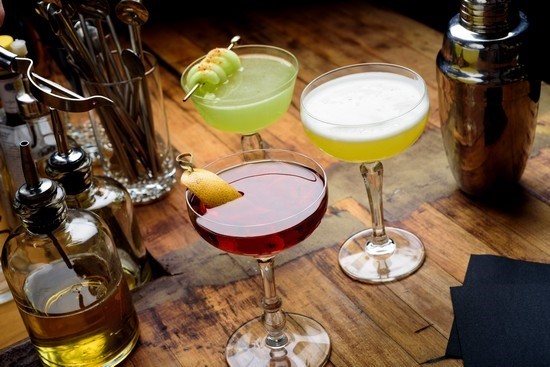 Clockwise from front,
the prietoni, the amoresperros, and the matador norteno, three cocktails on the
menu at La Contenta, in New York’s Lower East Side neighborhood, on April 21,
2015.
Clockwise from front,
the prietoni, the amoresperros, and the matador norteno, three cocktails on the
menu at La Contenta, in New York’s Lower East Side neighborhood, on April 21,
2015.
The vibe goes beyond products. Restaurants, coming out of the
pandemic into a new era of staff respect and community love, are sharing more
information about the people behind the food, whether listing the names of the
whole crew on the menu the way some restaurant name farms or, in the case of Hi
Felicia, a new kind of homegrown, high-end restaurant in Oakland, California,
encouraging diners get to know the entire staff by name.
And bonus small bitesCall these trendlets: In the beverage category, yaupon tea from
the American holly tree, is on a lot of lists for 2023, along with coffee
drinks made with fruit purée and milk, or roasted in a style called white
coffee. Avocados will be leaving toast and arriving in cocktails and desserts,
and avocado oil will be a favorite cooking medium. In boozy trends, watch for the
Mexican spirit called sotol and a retro interest in Galliano liqueur. Casual
restaurants will experiment with monthly subscriptions, and fancy ones with
aged fish. Fermentation continues its march to the top of a lot of lists, with
no-ingredient ingredients like no-bee honey and no-cacao chocolate.
Read more Good Food
Jordan News



